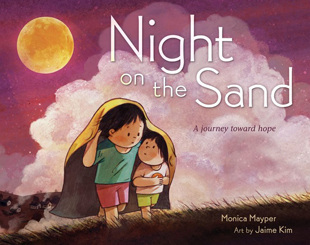According to the U.N. Refugee Agency, "Over half of the world's refugees are children. Many will spend their entire childhoods away from home, sometimes separated from their families." At the end of 2021, an estimated 36.5 million children were displaced from their homes.
The scale of this crisis is hard for any of us, even adults, to comprehend. But what a young reader can understand is the experience of a couple of brothers newly displaced and trying to find their way — the focus of Night on the Sand.
Wisely leaving the precipitating event open to interpretation ("a howl, a dark whirl of wind and power"), the story reveals that the children's home has been shattered and their parents have vanished. At first they have only each other. Even so, a feeling of safety comes through as the younger brother narrates:
We lay down on the beach to sleep.
I cradled my orange close.
My brother kept the blanket over us.
Their trusting hope allows them to keep going, caring for each other, and they meet up with others, who share food, water, and a warming fire. The younger of the brothers in turn shares pieces of his cherished orange. In such simple strokes, we understand that two crucially important things — community spirit and life itself ("I could hear my own heartbeat, breath move with the booom shhhh of the waves") — remain intact.
The story's tender message, meant for readers ages four to eight, is movingly furthered by New York Times bestselling illustrator Jaime Kim. Her paintings at child's-eye level show not only how the children and other refugees support each other, but also how nature embraces them with her beauty. As Monica Mayper puts it in her Author's Note: "The brothers' experience of catastrophe is harrowing, but they do not travel alone."
